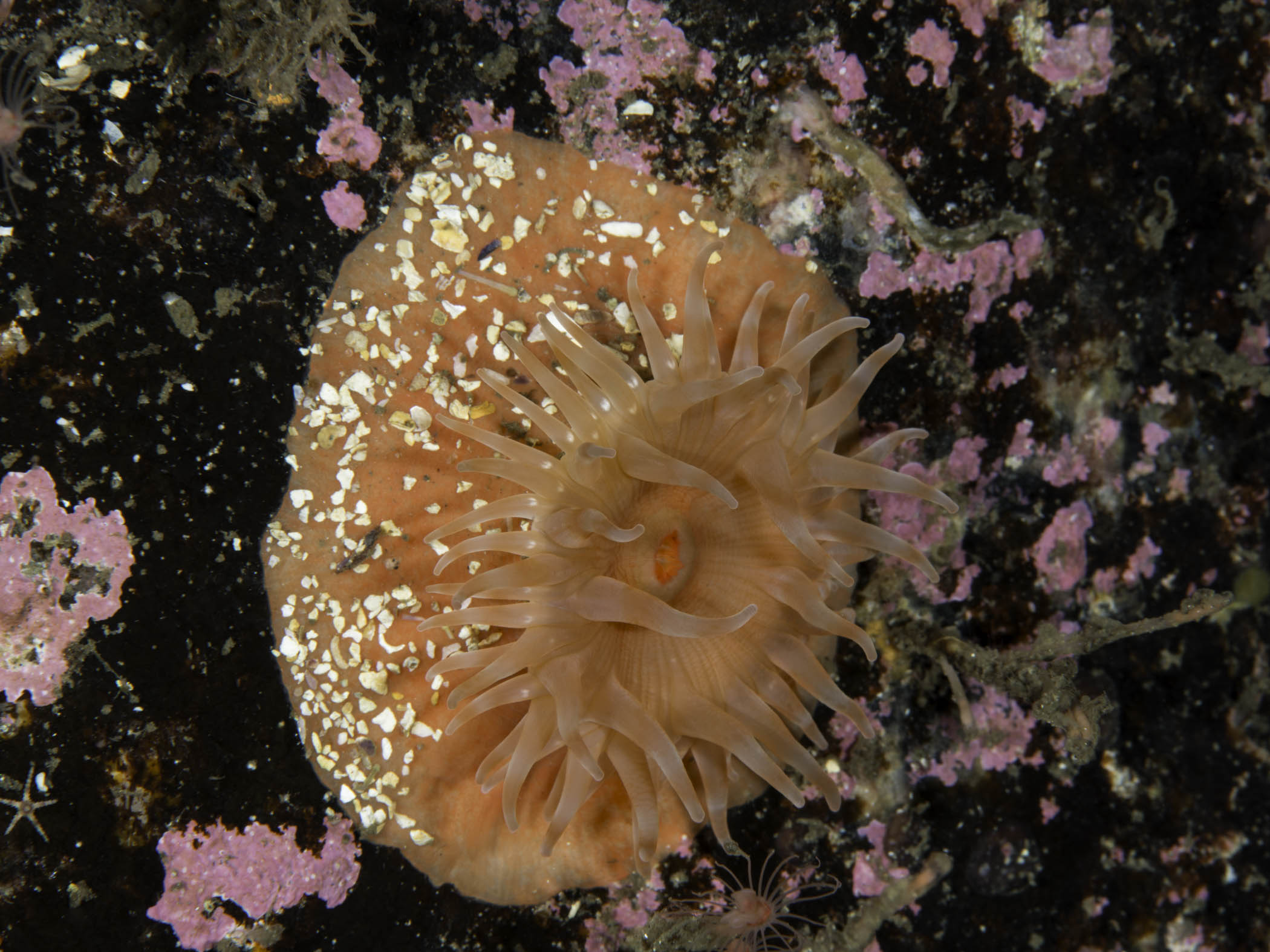Northern Ireland Priority species (NIPS)
| CNIDARIA : Actiniaria : Actinostolidae | SEA ANEMONES AND HYDROIDS |
Stomphia coccinea (O F Müller, 1776)
 |
| Stomphia coccinea |
A large, brightly-coloured anemone, living on sublittoral shells and stones. Northern Ireland has the only known locations in Ireland for this species, and its habitat is threatened by mobile fishing gear and possibly aggregate extraction.
In brief
- Found on numerous sites on the north-east and east coasts of Northern Ireland
- Sublittoral stones and shell debris from 10m to considerable depths
- Can be found throughout the year
- Northern Ireland has the only known Irish populations of this species
- Main threats come from habitat disruption, though the species may be vulnerable to climate change in its Northern Ireland locations.
Species description: This is quite a large anemone, its base and relatively smooth column both being about 70mm in diameter and height. It has two rings of tentacles, and unusually for anemones, the inner one has only six tentacles, whilst the outer has 10-12. The anemone varies in colour, mostly being white, orange, yellowish or brown and often blotched with red. A highly unusual characteristic, which has provoked a considerable amount of research, is its ability to disconnect itself from its substrate and swim in response to threats by predators such as starfish or sea slugs. It appears to do this by flexing its column, but the precise mechanism is still a matter for some debate.
Life cycle: There is no information on this for Northern Ireland, but it has been reported from elsewhere that external fertilisation takes place and the eggs develop into planktonic, plankton-feeding larvae, a mechanism which would encourage wide dispersal.
Similar species: Urticina eques is superficially similar, but is much larger, has two circles of ten tentacles each, and has small wart-like structures on its column.
How to see this species: The species is recorded from numerous sites on the north-east and east coasts of Northern Ireland, notably Rathlin, off Ballycastle, Tor Head, Ballygalley Head, and Island Magee and at the entrance to Belfast Lough. Off County Down it is found off the Copeland Islands and the northern parts of the Outer Ards. Its habitat is shell debris or stones, to which it attaches itself, and it is only sublittoral, occurring at depths ranging from 10m to considerable depths. There are no sites elsewhere in Ireland, and in Britain it is recorded from both western and eastern Scotland as well as north-eastern England. It is widespread throughout cold temperate and subarctic regions of the northern hemisphere.
Current status: Stomphia coccinea occurs in numerous locations in Northern Ireland. The species has no legal protection.
Why is this species a priority in Northern Ireland? Northern Ireland holds the entire Irish population of this species.
Threats: The main threat to this species is likely to come from disruption of its habitat by fisheries using mobile bottom trawling or dredging gear, by aggregate extraction. However, it is also possible that increases in sea temperature due to climate change might result in the range contracting northwards, and Northern Ireland must be regarded as being as one of the most southerly locations in Europe.
Distribution Map from NBN: Stomphia coccinea at National Biodiversity Network mapping facility, data for UK.
iNaturalist: Stomphia coccinea at iNaturalist World Species Observations database.
WoRMS: Stomphia coccinea at World Register of Marine Species. Accepted name: Stomphia coccinea (Müller, 1776). AphiaID: 100854.
Classification: Biota; Animalia; Cnidaria; Anthozoa; Hexacorallia; Actiniaria; Enthemonae; Actinostoloidea; Actinostolidae; Stomphia
| Previous species | Next species |
| Authors (2024). Stomphia coccinea. (O F Müller, 1776). [In] Priority species, Marine Biodiversity Portal NI. https://www2.habitas.org.uk/marbiop-ni/priorityaccounts.php?item=D11920. Accessed on 2025-04-20 |